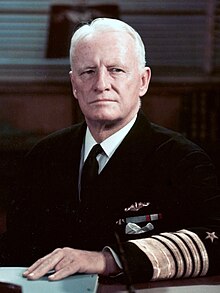
Back Chester W. Nimitz AF Chester W. Nimitz AN تشيستر نيمتز Arabic تشيستر نيمتز ARZ Çester Nimits AZ Чэстэр Ўільям Німіц BE-X-OLD Честър Нимиц Bulgarian Chester Nimitz BR Chester Nimitz Catalan Chester Nimitz Czech
Chester W. Nimitz | |
|---|---|
 Official portrait, c. 1945–47 | |
| Born | 24 February 1885 Fredericksburg, Texas, U.S. |
| Died | 20 February 1966 (aged 80) San Francisco, California, U.S. |
| Buried | |
| Allegiance | United States |
| Service | United States Navy |
| Years of service | 1905–1966[1] |
| Rank | Fleet Admiral |
| Service number | 5572 |
| Commands |
|
| Battles / wars | |
| Awards | |
| Relations | Charles Henry Nimitz (grandfather) Chester Nimitz Jr. (son) |
| Other work | Regent of the University of California |
| Signature | |
Chester William Nimitz (/ˈnɪmɪts/; 24 February 1885 – 20 February 1966) was a fleet admiral in the United States Navy. He played a major role in the naval history of World War II as Commander in Chief, US Pacific Fleet, and Commander in Chief, Pacific Ocean Areas, commanding Allied air, land, and sea forces during World War II.[2]
Nimitz was the leading US Navy authority on submarines. Qualified in submarines during his early years, he later oversaw the conversion of these vessels' propulsion from gasoline to diesel, and then later was key in acquiring approval to build the world's first nuclear-powered submarine, USS Nautilus, whose propulsion system later completely superseded diesel-powered submarines in the US. He also, beginning in 1917, was the Navy's leading developer of underway replenishment techniques, the tool which during the Pacific war would allow the US fleet to operate away from port almost indefinitely. The chief of the Navy's Bureau of Navigation in 1939, Nimitz served as Chief of Naval Operations from 1945 until 1947. He was the United States' last surviving officer who served in the rank of fleet admiral. The USS Nimitz supercarrier, the lead ship of her class, is named after him.
- ^ US officers holding five-star rank never retire; they draw full active duty pay for life. Spencer C. Tucker (2011). The Encyclopedia of the Vietnam War: A Political, Social, and Military History. ABC-CLIO. pp. 1685. ISBN 978-1-85109-961-0.
- ^ Potter, E. B. (1976). Nimitz. Annapolis, MD: Naval Institute Press. pp. 58–61. ISBN 0-87021-492-6.